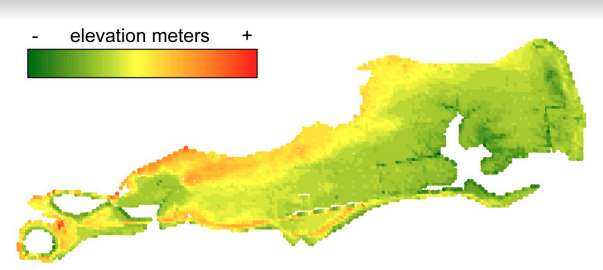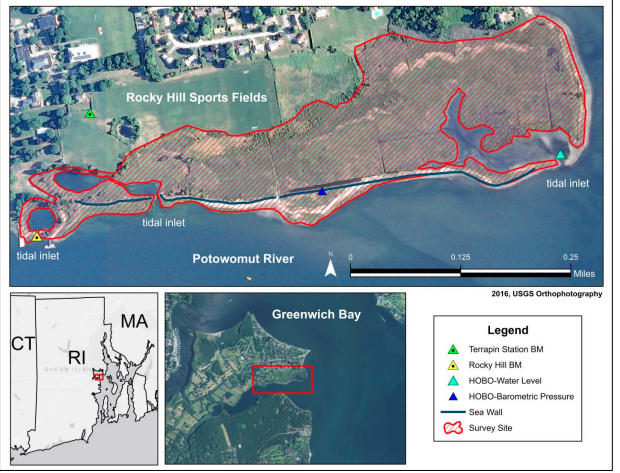Overview
The goal for restoration of the marsh located on the campus of the Rocky Hill School along the Potowomut River in East Greenwich, RI is to improve habitat for a recently discovered population of diamondback terrapins (Malaclemys terrapin). This brackish water turtle species is state-listed in Rhode Island. The terrapins have been observed using the site for nesting and the focus of the project is to increase nesting areas in order to sustain a thriving population. The project is in its second year of planning in order to assemble a dataset that will allow the development of an appropriate plan to restore the marsh to increase diamondback terrapin nesting habitat, increase hatchling overwintering habitat in the Spartina alterniflora wrack, and reduce predation pressure on the population. Ancillary outcomes of this habitat restoration effort include control of invasive Phragmites australis and enhanced resilience of the salt marsh to sea-level rise. As a part of the planning process, surveys have been conducted on vegetation, tidal elevation and wetland elevation, soils, and mapping of terrapin nesting sites, collection of hatchling emergence data, and propagation of S. alterniflora in a University of Rhode Island greenhouse for low marsh restoration and Ascelepias syriaca to increase pollinator habitat in the freshwater upland.
Quick Facts
Project Location:
Potowomut River, East Greenwich, RI, 41.6366408, -71.45440539999998
Geographic Region:
North America
Country or Territory:
United States of America
Biome:
Coastal/Marine
Ecosystem:
Coastal, Dune & Upland, Coral Reef, Seagrass & Shellfish Beds, Estuaries, Marshes & Mangroves, Other/Mixed
Area being restored:
16.1874 hectares
Project Lead:
The University of Rhode Island, under the direction of PI Dr. Laura Meyerson
Organization Type:
Other
Project Partners:
University of Rhode Island, Natural Resources Science Department
URI Environmental Data Center
Rocky Hill School
Coastal Resources Management Council (CRMC) of Rhode Island
Save the Bay
Natural Resources Conservation Service
Location
Project Stage:
Planning / Design
Start Date:
2016-06
End Date:
N/A
Planning \ Design:
24
Implementation:
24
Post-Implementation Maintenance:
24
Monitoring & Evaluation:
30
Primary Causes of Degradation
Climate Change, Dams & Hydrology, Fragmentation, Invasive Species (native or non-native pests, pathogens or plants)Degradation Description
At the Rocky Hill School marsh site, the main causes of degradation are the rising sea level, erosion from high energy tidal systems, human intervention in the form of damming and mowing, wall construction, marsh ditching, as well as invasive species colonization. Throughout Southern New England, coastal marsh systems are being inundated with tidal water at historical levels, an effect of global climate change. These systems are arguably the most affected by increasingly frequent storm events, bombarding the marsh with an abundance of precipitation and high-speed winds from hurricanes and other coastal storm systems. These weather events increase erosion of the shoreline and raise seasonal high tide levels. The Potowomut marsh was mosquito ditched, along with many other marshes, in the mid-1900s. Bisecting the marsh is a stonewall that interferes with sediment distribution along the shoreline; these changes in elevation and hydrology greatly affect vegetation distribution and the quality/area of terrapin nesting habitat. Minor restoration activities have been conducted within the site. A creek that flows in the marsh parallel to the shoreline was excavated to increase water flow into the marsh by the non-profit organization Save the Bay in 2014. In addition, some “runneling” has also been conducted within the marsh by Save the Bay (under the direction of Wenley Ferguson) to help drain inundated marsh areas. The effectiveness of these methodologies has not been quantified. This marsh is a rarity in that is it abutted by an upland barrier of relatively undeveloped land, granting it the opportunity to migrate inland in response to rising sea levels and restoration activities. Without appropriate restoration interventions, the upland barrier will be subject to tidal influx and the marsh will continue to subside.
Defining the Reference Ecosystem
The reference ecosystem is primarily based on contemporary reference sites or existing analogues of the pre-degradation ecosystem.Reference Ecosystem Description
The goal is to restore the Potowomut River salt marsh on Rocky Hill School’s property to the full extent of a self-sustaining and functional marsh. This includes habitat for coastal biodiversity, carbon sequestration and recreational value, protection against waves, storm surge, coastal erosion, and sea level rise. Reference sites include restored salt marsh sites, relatively undisturbed marshes, and sites where successful and thriving populations of terrapins nest. The planning process of this restoration is extremely thorough in order to ensure that the proper prescription of restoration actions is taken to reach these goals.
Project Goals
The ultimate goal for restoration of the marsh located on the campus of the Rocky Hill School along the Potowomut River in East Greenwich, RI is to improve habitat for a previously unknown population of diamondback terrapins (Malaclemys terrapin). Ancillary outcomes of this habitat restoration effort include control of the invasive Phragmites australis, and enhanced resilience of the salt marsh to sea-level rise. As a part of the planning process, surveys have been conducted on vegetation, tide elevation and wetland elevation, mapping of terrapin nesting sites, collection of hatchling emergence data, and propagation of S. alterniflora, A. syriaca.
Monitoring
Monitoring Details:
As the restoration is in the planning phase, much of the monitoring happening on site is gathering baseline data to determine an appropriate and effective restoration design.
Start date, including baseline data collection:
2016
End Date:
2018
Stakeholders
The primary stakeholders at this site are the owners of the marsh property, Rocky Hill School. Secondary stakeholders are the surrounding land and homeowners of the site, with whom the primary stakeholders wish to maintain positive and supportive relationships, URI, and CRMC.
Ecological Outcomes Achieved
Factors limiting recovery of the ecosystem:
Factors limiting the recovery of the ecosystem are the adaptability of terrapin nesting habits during peak restoration implementation, where many disruptive activities may be going on along the shoreline. Funding is also a limiting factor, as the project in contingent upon the approval of funding proposals at grant agencies. Stakeholder buy-in from local residents is also a potentially limiting issue.
Socio-Economic & Community Outcomes Achieved
Economic vitality and local livelihoods:
The prolonged resiliency of the salt marsh will help preserve the industry of quahoging, shellfishing and fishing that happens along the marsh and within the greater Narragansett Bay. The marsh at Rocky Hill is a crucial source of food, shelter, spawning, nursery areas and refuge from predators for fish and shellfish.
Cultural dimensions such as recreational, aesthetic and/or spiritual:
While difficult to quantify, there is typically vast public support for salt marsh restoration in Southern New England. Restoration increases recreational value, property value, and wildlife habitat, which many people claim to value. The marsh property is open to the public and frequented by many community members for walking, kayaking, swimming, sailing and fishing.
Regulation of climate, floods, disease, erosion, water quality, etc.:
The marsh and its plant community protects from high energy storm systems, taking on a portion of the velocity and water that would otherwise inundate its surrounding community.
Has the project had any negative consequences for surrounding communities or given rise to new socio-economic or political challenges?:
The restoration is expected to temporarily limit recreational access to the beachfront of the marsh and the boating area approximately 10 meters off shore. This delineated boundary will prevent any disturbance to the nesting season of the terrapin population, as well as allow for safe and uninterrupted implementation of restoration design when the project reaches that phase.
Key Lessons Learned
The ongoing planning stages of this project limit evaluation as lessons are developing as restoration initiatives more forward. However, as the planning stages have resulted in more data, focus of restoration design has shifted. Initially, it was thought that the success of the terrapins nesting season was limited by predation and recreational land use. While this is partially true, our baseline data findings indicate that the dysfunctional and chaotic structure of the marsh zones, hydrology, and sediment deposition are more likely to be limiting the suitable nesting habitat available for terrapins.
Long-Term Management
It is anticipated that yearly monitoring will follow post-implementation, to measure success and for publications. The strong support from and relationship with the Rocky Hill School and URI will continue throughout the restoration process and will provide excellent experiential learning and internship opportunities for Rocky Hill, URI and other students.
Sources and Amounts of Funding
$15,700 USD total.
Rhode Island Coastal Resource Management Council (CRMC)- $15,000 USD
Rocky Hill School – $700 USD
Other Resources
Rocky Hill High School student, Jenna O’Del, served as an intern on the project, as well as five URI undergraduate students: Marina Capraro, Jordan Powell, Timothy Alfrey, Joe Johnstone, Demmetrious Dawkins. This strong relationship with the Rocky Hill School and URI will continue throughout the restoration and will provide excellent experiential learning and internship opportunities for Rocky Hill, URI and other students. Meyerson’s team of students are also conducting outreach to the local community – adjacent property owners to the Rocky Hill School and other property owners on both sides of the river. In addition, the restoration team sought expert input from stakeholders such as Save the Bay, CRMC, DEM, The Nature Conservancy, and the Rhode Island Natural History Survey. The multidisciplinary nature of this project will allow for more collaboration and cohesion with different organizations throughout the state of Rhode Island. Finally, the activities on the Potowomut marsh provide an excellent case study and the data that this project produces will be shared with Dr. Meyerson’s URI classes – Conservation Biology, Restoration Ecology and Invasive Species Ecology, Policy and Management.
Related Research
Dr. Laura Meyerson is a researcher in the realm of biological invasions, focusing predominantly on P. australis. Treatments and control technique of invasive common reed on site are likely to appear in future publications.Primary Contact
Name:
LAURA AHEARN MEYERSON
Affiliation:
The University of Rhode Island, Department of Natural Resources Science
City:
KINGSTON
State:
RI



